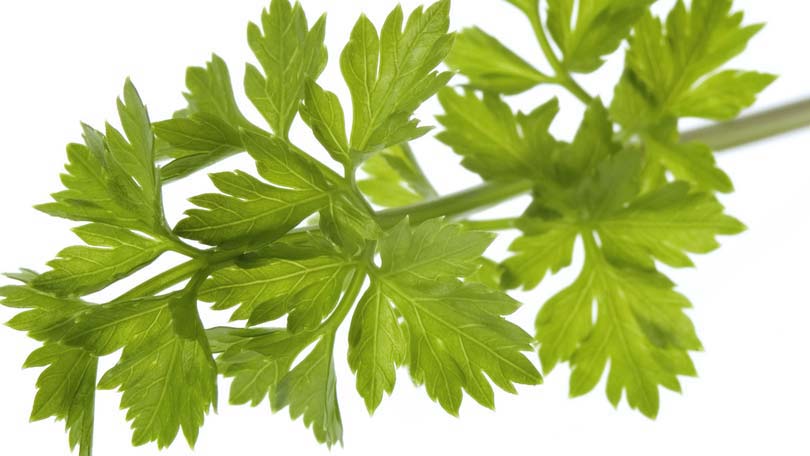
Parsley (Petroselinum crispum), a member of the carrot family and relative of dill and fennel, is easily one of the most important herbs in European cooking. It was once synonymous with celery in ancient Rome and has been on of the most dominant kitchen herbs in the last two thousand years. The plant, which is native to Europe and West Asia, has a distinctive green, fresh flavor that brightens a variety of dishes and is very versatile – it can be used as a garnish, as is frequently done in North American cuisine, a vegetable, or as a main flavoring component or spice.
Characteristics
Parley is a small (around 6 to 12 inches in height), delicate looking biennial with a bright green coloring and lacy, attractive leaves. There are two main varieties which have relevance in the kitchen: curly and flat-leaf. Curly parsley has, of course, slightly curled leaves which are very pretty and preferred for garnishes; the leaves have a mild, woody flavor that grows more intense as the plant ages. Curly parsley also has a pleasantly crisp texture. Flat leafed, also known as Italian, parsley has a more distinctive “parsley” flavor and tends to mellow with more woody tones later in life; it is less crisp and does not work as well for garnishing.
Parsley is fairly easy to grow in home gardens, needing only minimal attention and reliable sunlight; however its seeds take a long time to germinate, which can be a turn off for home cooks who can easily purchase the leaves at the store. Inside the home it requires only a good deep pot, healthy soil, and at least five hours of sunlight a day. Home gardeners should be on the lookout for insect damage as parsley is targeted by some moths and other insects.
Common Uses
Parsley is closely associated with Middle Eastern, Mediterranean, and European cooking. It is used primarily for seasoning dishes but in some regions is so frequently utilized it can take on the role of vegetable (as is common in Middle Eastern cuisine). European and American cuisine tend to utilize curly parsley the most, chopping it for seasoning or using whole sprigs as a garnish. Middle Eastern cookery, which uses parsley for cooking more than as a garnish, more often picks the flat leaf variety for its stronger flavor. Parsley is generally chopped and added to salads, sauces, egg dishes, and grain dishes; it can be used whole or chopped to garnish meats, vegetables, potatoes, salads, soups, stews, braises, fish, seafood, or rice pilafs. The best known dish using parsley is Middle Eastern tabbouleh, a grain salad made with wheat bulgur and entire cups of chopped parsley; it also appears in Moroccan tagines and French persillade. Parsley also blends well with other herbs and can appear in French fines herbes mixs or in a traditional bouquet garni (bundled parsley, bay leaf, thyme, and sometimes marjoram).
Parsley is high in vitamins A and C and therefore has proven antioxidant activity. Historically it has been used medicinally to treat digestive issues, respiratory ailments, and kidney problems such as urinary tract infection. It also has been used to treat fatigue, melancholy, light headedness, poisoning, inflammation, and immune weakness. Tonics or teas brewed from the leaves have been used as a diuretic and to stimulate contractions during the birth process, and some herbologists claim parsley can treat high blood pressure. The herb’s high levels of chlorophyll make it a reliable breath freshener when chewed after meals.
Use and Storage
Parsley is easily obtained at pretty much all stores and markets where produce is sold. It can be rinsed and stored in the fridge in a jar of water, or wrapped in foil and frozen for later use. Dried parsley is also available in most spice aisles but loses its flavor quickly; it will keep for a couple of months at best when stored in an airtight container out of direct sunlight.
Use It:
- in tabbouleh
- chopped and added to salads
- in herb mixes or a bouquet garni
- added to cheese spreads or dips for crackers and crudités
- deep fried and arranged as a garnish
- to season vegetables, potatoes, and pureed squashes
- in rice dishes like pilaf
- sprinkled over meat, fish, seafood or egg dishes
- in pesto and other sauces
- sautéed with garlic and butter for garlic bread
- with lemon on baked or roasted fish
- to freshen breath after a meal
Recipe using Parsley
Easy Herb Bread Spread
5 cloves of garlic, minced
1 tbsp. red pepper flakes
3 tbsp. fresh chopped basil
6 tbsp. chopped fresh parsley
Juice of one lemon
1/3 cup extra virgin olive oil
Salt and freshly ground black pepper to taste
Combine ingredients in a small bowl and whisk together to blend. Spread onto freshly toasted baguettes and serve with slices of parmesan cheese.
